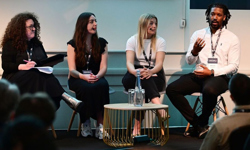Mike Ironside could have been forgiven if he had decided it was really too much bother to become chief executive of the National Readership Survey (NRS).
Despite coming from an agency background and being former commercial director of the Daily Mail and managing director of the Mail on Sunday – an ideal background you would think - he was subjected to “the most ludicrous protocol I have ever gone through”.
Ninety-one people were interviewed for the job, and there were long lists, short lists, a vast number of meetings and delay over seven months, he recalls. The process was itself a powerful symptom of the problems facing the organisation.
At the end, and despite everything, Ironside decided to give it a try.
“I’m glad I stayed and it’s worked out pretty well,” says Ironside who has now delivered what the publishing and agency world has wanted for years, the integration of online digital data with the established print survey.
PADD
NRS PADD (Print and Digital Data) was launched in September with the latest quarterly research published at the end of May.
“We now have the figure for print and digital, with duplication and deduped, what the two audiences are, where they overlap, and what your net audience is and that is what they have never had before,” Ironside explains.
As a result, publishers, the NRS chief executive argues, now have some of the single largest audiences that they have had for 25 years, albeit split into different pieces. And the information now comes, not from individual proprietors, but with the authenticity of a joint industry standard behind it.
The latest figures show, for example, that the net daily readership for the Daily Telegraph and telegraph.co.uk is 2.94 million, a rise of 54.9 per cent thanks to the addition of online.
The numbers for the Guardian are 2.316 million and 125 per cent, with the Independent 902,000 and 103 per cent.
The impact of the paywall at the Times is dramatic in terms of net readership – 1.34 million readers but with online providing a daily lift of only 2.7 per cent.
Ironside concedes that NRS does not tend to be ahead of the curve, and is usually playing catch-up.
“We did all of this in 18 months which for the NRS is the blink of an eye and we had to get agreement at every stage and the devil was in the detail. What was going to happen for the Daily Mail was different to what was going to happen for the Anglers Mail,” says Ironside.
The digital numbers are realistic – after all, NRS doesn’t count the individual pages read in a newspaper so why produce ridiculously high numbers for each digital page engagement.
Monetising digital
“The basic thing here is the enormous drive to get this data now in the format where publishers can monetise the digital part of the equation,” Ironside says.
Despite the improved numbers, many publishers still have to be realistic about the balance between print and digital revenues, with about 85 per cent of magazine revenue still coming from print.
It would therefore be “absolutely bonkers” if they were distracted by digital from paying full attention to their print businesses.
“The tipping point (into digital only) for some publishers – AutoTrader for instance - has come earlier than others, but while you still take the revenue some titles take, it is impossible to ignore the print product,” Ironside argues.
Overall, Ironside is an optimist about the sector mainly because of the continuing innovation in both products and distribution, developments such as the free Evening Standard and TimeOut going the same route and immediately boosting its readership by 49 per cent.
Ironside was brought into the NRS to carry out “a piece of change management”. The survey, he believes, had become a rather arcane technical operation that was perceived as not engaging sufficiently with the users who are also the owners – newspapers, magazines and agencies.
Ironside thought it would be an interesting challenge. Now, after four years in charge, he says it has been “beguiling” because it turned out to be such “a vast opportunity to change something and leave a legacy” with a staff of only six.
Ringing the changes
The changes began almost immediately after Ironside took over. He stopped sending out the survey in the form of a 500 page book when everyone was using the digital version. Only one person, a media commentator who liked collecting the publications, complained.
The board was cut from 12 people to six and met six times a year instead of monthly.
At one meeting, Ironside asked exactly when the NRS talked to its users and was met by silence. No one spoke on any regular basis to those who ended up doing the planning, buying and selling.
The user group meetings are now “invigorating” with anyone free to turn up and say what they want to get out of NRS and what they don’t like.
“Some people who attended the first meeting still come, so it must have value for them,” says Ironside who has held members’ contributions fixed by imposing a continuing wage freeze and the re-negotiating of contracts with the body’s main suppliers responsible, for example, for 36,000 interviews a year.
The openness has extended to the creation of an app which is available free of charge giving net coverage of print and digital and updating itself automatically.
To help end the perceived rivalry between NRS and the ABC both Ironside and ABC chief executive Jerry Wright address each other’s board once a year on upcoming projects and the two organisations also share a PR representative – Eulogy - to help unify the message.
Apart from the structural changes, the key thing for Ironside was accepting that the survey was not a piece of work to be proud of.
“I refused to allow it to be called Gold Standard because I think you set yourself up for a fall and they had had so many arguments with users up to that point,” says Ironside.
The issues included the size of the London sample and its ability to adequately pick up young readers and, particularly, the volatility of numbers in individual periods.
Small numbers and sample size can make a difference, as can changes in distribution in the short term.
“But if you look at the ten-year trends you will see that circulation and readership trends absolutely mirror each other. You have to make major changes to a title to have major changes in its sales data,” insists Ironside.
On the significant issue of digital, the NRS executive believes NRS would have become increasingly marginalised if it had stayed in print alone. The path, however, was clear to push ahead with PADD because that was what his shareholders were also saying.
Katherine Page, a former senior director at Ipsos, was the core consultant on the PADD project and each board member was given a personal technical buddy to guide them through the intricacies.
“When regression to the mean came up on the screen you could see the look of horror on everyone’s face – magnificent,” Ironside recalls.
Over the past 18 months, NRS has seen more than 2,500 people in the publishers and agencies and offered training mainly through workshops.
Naturally, when one trick has been successfully accomplished the demands for the next one increase.
The next trick
“When do we get mobile and when do we get tablet; those are the key issues now,” admits Ironside who also concedes that demands for similar data on social media are rising.
The PADD name was chosen so that other material from different platforms can be added in future.
“We believe we will have mobile and tablet established within another 18 months and maybe slightly earlier. It depends on whom we decide to partner with and the data sets we use,” he adds.
The print-digital figures are based on a fusion but because of the relatively small numbers involved in mobile and tablets, a different method may have to be used. There is also the problem that existing data on mobile and tablets tend to reflect machines and IP addresses rather than the actual activities of people.
It amounts to work in progress.
Social media will definitely become part of the programme but will stay firmly in third place after mobile and tablets.
“Who’s to say that Google won’t be a supplier of this data rather than Comscore and Neilsen. Maybe they will be a provider of it and maybe we will have to consider them in future,” muses Ironside.
One thing that is not on his agenda is a merger between NRS and ABC. The issue was looked at in 2008 but rapidly dismissed.
The bodies do such different work, with the ABC responsible for auditing newspaper and magazine circulations, that no real synergies could be found.
“They audit figures given to them by the newspapers and magazines. We go and do research independently and we don’t rely on anyone to give us data. People should see the complementarity of it. There is no sense of rivalry,” emphasises Ironside.
One of the trends though is for NRS to use its data more widely and become an information hub for others.
NRS recently signed a partnership agreement with JICEG, the regional media research organisation. NRS will collect readership data for all of Britain’s regional newspapers. The regional titles will be included in the 36,000 face-to-face interviews.
Next up for Ironside, the plan that before long, print and PADD data will be released on the same day – something he believes would make a lot of sense.
By now, Ironside, who has recently turned 60, could have been on the way out of NRS. The change management has been accomplished and PADD delivered. It would have been a neat time to bow out and do more of the things he likes doing such as travel, spending more time with his family and watching Chelsea.
Instead, he has signed up for another two years.
Will it be time to go after mobile, tablet and social networks?
Maybe, but then again maybe not, because Mike Ironside likes the executive rather than the non-executive life – doing things and making sure they happen and there will be no shortage of things to do.












